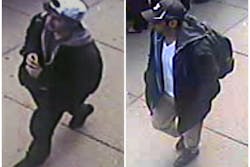Video surveillance plays key role in Boston's bombing investigation
What began decades ago in the UK as a way to control soccer hooliganism has come full circle as a result of the senseless bombings this week during the Boston Marathon. The use of video surveillance by law enforcement, with the cooperation of the private sector, not only captured the bombing events, but has been a key to identifying the bombers themselves.
Urban video surveillance deployment is the fastest growing sector in the video world. Cities ranging from metropolises like New York City and Chicago to smaller burgs like Wilkes-Barre, Pa., and Sandy Springs, Ga., have made video an integral part of their secured cities plan. New York Mayor Michael Bloomberg recently said that Americans should get used to “more visibility and less privacy,” because he predicts that “there will be cameras every place,” in the next five years in urban spaces.
And following Monday’s Boston bombings Rep. Peter King (R-NY), who is the chairman of the Homeland Security Subcommittee on Counterintelligence and Terrorism, told MSNBC that he thinks more cameras in public spaces are needed in light of recent events.
“We have to stay ahead of the terrorists and I do know in New York, the Lower Manhattan Security Initiative, which is based on cameras, the outstanding work that results from that,” said King on the newscast. “So yes, I do favor more cameras. They’re a great law enforcement method and device. And again, it keeps us ahead of the terrorists, who are constantly trying to kill us.”
Perhaps the biggest boost to the use of video surveillance in the urban environment has been the unprecedented openness the FBI has employed with the recorded feeds from both the private and public sector cameras. Never has the federal agency relied so much on the public’s help in apprehending terror suspects or released sensitive video with such enthusiasm as has occurred this week. It is estimated that the downtown Boston area has close to 150 video cameras and more than 400 on the city’s buses and subways. The speed with which the Boston video surveillance network has aided in capture of the bombing suspects is reminiscent of the investigation of London’s 7/7 bombings, where video was an integral part of the investigation.
“They caught those guys by the next day because London is virtually a Hollywood studio, cameras all over the place. I went to the headquarters late that night and they had already picked the guys out, they had them in freeze frames, the guys that they thought did it,” former New York mayor Rudy Giuliani told CBS News.
Law enforcement’s use of video surveillance in large spectator events like marathons and professional stadium sports has become the norm. Video played a major role during the investigation of Bryan Stow’s beating in the parking lot of Dodgers’ Stadium following their game with the San Francisco Giants in 2011.
In an evolving world of slashed public safety budgets and lost manpower, video is being relied upon as a law enforcement force multiplier. Unfortunately for many city administrators, funding initiatives for municipal video projects have changed, and state and federal grants have been lessened to the point where cities and municipalities have to look for other areas to gain monies.
This funding dilemma is forcing some public/private partnership initiatives to search for more creative ways to implement their surveillance programs.
Rob Welton, Siemens’ national business manager for enterprise solutions for infrastructure and cities, shared how his group is working with cash-strapped communities to bring their video security initiatives online. He said he is currently working on a project involving a smaller city where they found savings in the energy management grid that helped them realize enough savings to fund their initial video surveillance purchase.
“If we can tell the city manager and police chief that we can show them how to finance their PSIM, their VMS and cameras without additional tax initiatives or pulling funds from other city projects, they can make a plausible pitch for implementation,” said Welton of the program he called ‘Performance Contracting’.
Any public safety official will agree that video cameras are not a substitute for line officers. However, the quick resolution to the terror events at this week’s Boston Marathon certainly demonstrate that if cameras are combined with other proactive law enforcement procedures, they can be a technology asset.
As conference chairman, I welcome you to join us for our upcoming Secured Cities Conference, November 14-15 in Baltimore, Md. There will be intense educational and peer-to-peer encounters to help law enforcement, city administrators and all stakeholders in the urban security environment learn how technology can make a difference in your security planning and understand your funding options to attain your goals. Go to www.securedcities.com for more information and to register for this unique event.
About the Author
Steve Lasky
Editorial Director, Editor-in-Chief/Security Technology Executive
Steve Lasky is Editorial Director of the Endeavor Business Media Security Group, which includes SecurityInfoWatch.com, as well as Security Business, Security Technology Executive, and Locksmith Ledger magazines. He is also the host of the SecurityDNA podcast series. Reach him at [email protected].

